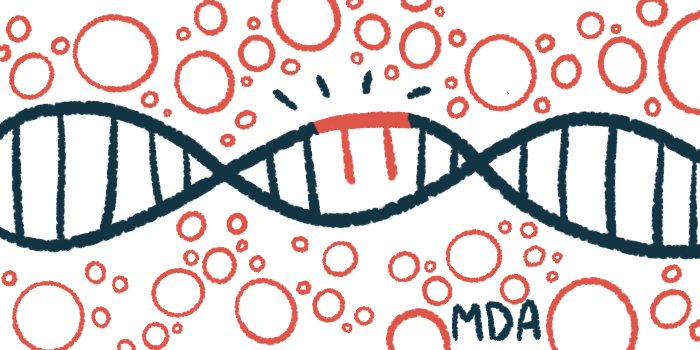MDA 2025: Benefits seen for 3 OPMD patients given gene therapy
BB-301 treatment for MD type leads to swallowing improvements in trial

The use of experimental gene therapy BB-301 led to improvements in swallowing ability for the first three people with oculopharyngeal muscular dystrophy (OPMD) — a type of muscular dystrophy marked by muscle weakening in the throat and eyes — in a clinical trial.
That’s according to interim data shared at the Muscular Dystrophy Association‘s 2025 MDA Clinical & Scientific Conference, held last month in Dallas.
Improved swallowing ability among these individuals was seen irrespective of what specific types of swallowing problems the patients were experiencing prior to gene therapy, the researchers noted.
These new data were shared in a talk titled “Interim Study Update for the BB-301 Gene Therapy Phase 1b/2a First in Human Trial in Subjects with Oculopharyngeal Muscular Dystrophy with Dysphagia.” The trial is sponsored by BB-301’s developer Benitec Biopharma; two of the study’s nine researchers are employed by the company.
“Across the [participants] and across the two discreet causes of [swallowing problems], we saw very meaningful improvements,” Jerel Banks, MD, PhD, executive chairman and CEO of Benitec, said at the MDA conference.
OPMD gene therapy targets mutations in PABPN1
OPMD is a form of muscular dystrophy characterized by weakness in the muscles of the eyes and throat. It almost always leads to problems swallowing, medically known as dysphagia. People with OPMD may experience inefficient swallowing, where bits of foot or liquid remain in the mouth, or ineffective swallowing, in which the muscles of the throat tighten up repeatedly without relaxing to let in more food or liquid.
This disease type is caused by mutations in the PABPN1 gene. BB-301 uses what’s known as a silence and replace strategy, and is given by injection directly into the muscles of the throat. It essentially aims to inactivate the mutated PABPN1 gene while simultaneously delivering a healthy version of the gene to patients’ cells.
“We are endeavoring to improve swallowing, the key feature [of OPMD],” Banks said.
The gene therapy is now in clinical testing in a Phase 1b/2a trial (NCT06185673) at a single U.S. location. So far, five patients have received a low dose of BB-301, with data indicating a positive safety profile, with no severe side effects reported. A sixth patient is expected to receive the low dose in the coming months, and Benitec plans to start testing a higher dose later this year.
The trial, taking place at a site in New York, is still recruiting adults with OPMD, ages 65 and younger, who have completed at least six months of follow-up in a natural history study run by Benitec.
“The sixth and final [participant] of cohort [group] 1 will be treated with BB-301 in the second calendar quarter of this year, and we are highly optimistic about the potential for continued benefit in [individuals] enrolled in the ongoing clinical study,” Banks said in a company press release announcing the MDA presentation.
“We look forward to enrolling additional [patients to receive] the next, higher dose of BB-301 later this year,” Banks said.
Trial testing BB-301 expected to enroll 30 patients
The MDA presentation detailed the effects of BB-301 on the first three participants’ swallowing ability.
Before receiving gene therapy, the first individual had mainly complained of inefficient swallowing. Video-based assessments showed that, one year after BB-301 treatment, this patient had substantially less residual material in the throat after swallowing. Specifically, the patient had a 37% reduction with thin liquids like water, a 29% reduction for thick liquids like yogurt, and an 18% decrease with solid food.
We are highly encouraged by the clinically significant improvements observed for the first three [participants] treated with BB-301, with [participants 2 and 3] each achieving clinically normal swallowing profiles.
The second and third participants also had been struggling with ineffective swallowing before gene therapy. For the second participant, before gene therapy, about 80% of swallowing attempts had abnormal constrictions of throat muscles. At one year after BB-301 treatment, however, 17% of swallowing attempts showed these abnormalities.
Similar improvements were seen in the third participant, who has so far been followed for only three months after BB-301 treatment. Abnormal throat movements were seen in 84% of swallowing attempts before gene therapy but were not seen at all as of the latest follow-up.
All three individuals also reported improvements in a patient-assessed measure of swallowing ability called the Sydney Swallow Questionnaire (SSQ). Indeed, the second and third participants both had SSQ scores within the range that’s considered normal at the latest follow-up. For the first participant, SSQ scores improved by 41%, but were still worse than normative values.
“We are highly encouraged by the clinically significant improvements observed for the first three [participants] treated with BB-301, with [participants 2 and 3] each achieving clinically normal swallowing profiles based on the results of the respective reductions in their total dysphagic symptom burdens,” Banks said.
The BB-301 trial is expected to ultimately involve about 30 patients.
The therapy has been awarded orphan drug status in both the U.S. and the European Union. That designation is given to medicines for rare diseases, defined in the U.S. as those affecting fewer than 200,000 people, and in the EU as conditions affecting fewer than 5 in 10,000 individuals. Such status provides incentives, including market exclusivity and reduced fees, for developing treatments for these diseases.








